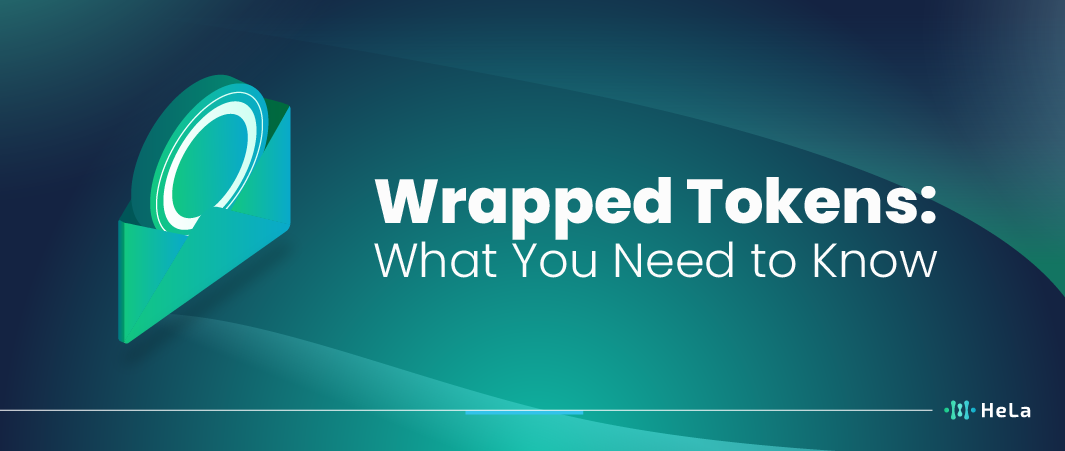In the dynamic world of cryptocurrencies, terms and concepts emerge that might seem intricate at first glance. One such term that has gained significant attention lately is the “wrapped token.” But what is a wrapped token, and why is it becoming increasingly essential in the decentralized ecosystem? This article delves into the intricacies of wrapped tokens, providing insights into their functionality, purpose, and the value they bring to the blockchain realm.
The rapidly expanding universe of decentralized finance (DeFi) has birthed a plethora of innovations. These developments cater to the growing need for interoperability and ease of transaction between different blockchains. Wrapped tokens have emerged as a powerful solution to these demands, serving as a bridge between disparate platforms.
Whether you are a blockchain enthusiast, a developer, or simply someone keen on understanding the latest in the crypto domain, this comprehensive guide on wrapped tokens will shed light on all the pivotal aspects you need to grasp.
What is a Wrapped Token?

A wrapped token is essentially a cryptocurrency token pegged to the value of another cryptocurrency. It operates on a specific blockchain but represents the value of an asset from another blockchain. For instance, a wrapped Bitcoin (WBTC) exists on the Ethereum blockchain but holds the value equivalent to one Bitcoin. The ‘wrapping’ process involves locking up the original asset in a smart contract and then minting an equivalent value of the wrapped token on another blockchain.
This process of creating wrapped tokens ensures that the value remains consistent across different blockchains. It also introduces a standard ERC-20 token on platforms like Ethereum, ensuring compatibility with existing infrastructures like wallets, exchanges, and smart contracts.
The Purpose Behind Wrapped Tokens

The primary purpose of wrapped tokens is to bring about interoperability among different blockchains. As various blockchains have evolved, each with its unique features and benefits, there was a growing need to facilitate smooth transactions between these diverse platforms.
Enhancing Liquidity
To boost liquidity, people can make wrapped versions of their native tokens on well-known platforms like Ethereum. This helps move assets smoothly between different blockchains. This is super important for decentralized exchanges (DEXs) that work on one blockchain but want to include assets from another chain. By wrapping tokens, users can trade them easily on DEXs, expanding the variety of assets available for trading.
Imagine you have a favorite exchange operating on Ethereum, and you want to trade tokens from a different blockchain, like Binance Smart Chain. Wrapping those tokens allows you to bring them into the Ethereum ecosystem, making them compatible with the DEX. This process not only opens up more trading possibilities but also increases the overall liquidity in the crypto world, making it easier for people to buy and sell a wide range of assets. It’s like adding more ingredients to a recipe, making the crypto market more diverse and vibrant.
Also Read: What is Layer 1? Definition and How does it work
Expanding Utility
Wrapped tokens are like magic bridges in the world of cryptocurrencies. They let you take assets from one blockchain, like Bitcoin, and use them in different apps on another blockchain, such as Ethereum. Imagine you have Bitcoin (WBTC), and now you can use it in all sorts of cool Ethereum apps. This makes life easier for Bitcoin holders because they can do more with their coins and explore new possibilities in the world of decentralized applications.
So, instead of just keeping your Bitcoin in a wallet, you can put it to work in games, finance apps, and more on Ethereum. It’s like having your cake (Bitcoin) and eating it too (using it in various dApps). This opens up a whole new world of opportunities for cryptocurrency enthusiasts, making the crypto space even more exciting and interconnected.
Simplifying Transactions
Wrapped tokens make it easier for people to move their digital assets between different blockchains. Instead of dealing with the tricky process of swapping assets between two separate blockchain networks, users can now just change their assets into a wrapped form and use them in the blockchain they want.
Let’s break it down further: Imagine you have a digital coin that belongs to one blockchain, and you want to use it on a different one. Instead of going through a complicated exchange process, you can change it into a wrapped version, which is like a universal currency that can be used on various blockchains. This simplifies things for regular users and helps them seamlessly operate within their preferred blockchain ecosystem.
The Process of Creating Wrapped Tokens

Wrapped tokens are a crucial component of blockchain ecosystems, enabling the seamless representation of assets from one blockchain on another. The creation and redemption of wrapped tokens are governed by a set of predefined protocols, which ensure transparency, security, and interoperability across different blockchain networks. Here’s a comprehensive step-by-step guide to understand this process:
1. Token Selection
To get started, you, as a user, simply pick the digital asset you’d like to convert into a wrapped version. This could be something like Bitcoin (BTC) or Ethereum (ETH), or even other digital assets from a particular blockchain network. This choice essentially means you’re taking your original asset and creating a counterpart that can be used on a different blockchain or in various decentralized applications (DApps). It’s like putting your asset into a special digital wrapper, allowing it to interact with a broader range of platforms and services.
2. Bridge Protocol Selection
When users want to move their assets between different blockchains, they need to pick a bridge or protocol to help with the process. These bridges are like middlemen that make it easier to transfer assets. Some well-known bridge protocols are Wrapped Bitcoin (WBTC) and Wrapped Ethereum (WETH), among others. Each of these is tailored to work with specific blockchains, so users choose the one that matches the blockchain they’re using to ensure a smooth asset transfer.
3. KYC and AML Compliance (Optional)
Depending on the rules of the bridge and the laws in force, users may be asked to complete Know Your Customer (KYC) and Anti-Money Laundering (AML) procedures to make sure everything is above board. This usually happens when dealing with centralized or government-regulated services that offer wrapped tokens. These checks are in place to verify users’ identities and ensure that they’re not engaging in any illegal financial activities, like money laundering. So, it’s like an extra layer of security and transparency to keep everything legal and safe when using these services.
4. Asset Locking
Asset locking involves securely storing your original asset on a digital ledger, called a blockchain, by using a smart contract. This smart contract ensures that your asset is not only kept safe but also easily verifiable by anyone on the blockchain network. Think of it as putting your valuable item in a virtual safe that’s transparent and tamper-proof, providing peace of mind and trust in the digital world.
5. Issuance of Wrapped Tokens
Once the asset is securely locked up, a corresponding set of wrapped tokens is created on the desired blockchain. These wrapped tokens usually take the form of ERC-20 tokens on Ethereum or similar tokens on other blockchains. Think of these wrapped tokens as digital representations of the locked assets, making them easily transferable and tradable on the blockchain of your choice. This process allows you to use your assets in various decentralized applications and access the benefits of blockchain technology, all while ensuring your original assets remain safe and sound.
6. Proof of Reserve
Proof of Reserve is a way to make sure that wrapped token systems stay honest and reliable. It’s like a regular checkup to show that the money supporting these tokens is actually there on the main blockchain. This helps everyone trust the system more because they can see the proof that their tokens are backed by real assets. It’s like having a transparent window into the vault to ensure everything is as it should be. This simple but important process helps maintain trust in the wrapped token system.
7. Transfer and Use
Now, users have the flexibility to easily move and utilize their wrapped tokens on the new blockchain of their choice. This means they can take part in decentralized finance (DeFi) actions, trade on decentralized exchanges, or simply store the wrapped tokens, much like they would with any other digital currency. This newfound freedom gives people more options and opportunities when it comes to managing their cryptocurrency investments and engaging in various blockchain activities.
Redeeming Wrapped Tokens
Redeeming wrapped tokens follows a similar process in reverse. This can be done on various blockchain platforms, and it’s often used when you want to use your tokens in their native form or transfer them to a different blockchain. It’s a way to unlock the value of your wrapped tokens and make them more versatile in the crypto world.:
1. Token Selection
To select the wrapped token you wish to redeem, kindly choose the one that aligns with your preference. This process is akin to selecting your preferred confection from an assortment of chocolates. The decision is entirely yours, so feel free to designate the token that best suits your needs. Take this opportunity to make your selection at your convenience.
2. Bridge Protocol Selection
When deciding how to connect with a specific blockchain, you need to pick the right bridge or protocol. This choice is essential because it determines how data and transactions are transmitted between your system and the target blockchain. Think of it like choosing the right path to get from one place to another. Depending on the blockchain you’re working with, you’ll need to consider factors like speed, security, and compatibility. So, take a moment to weigh these aspects carefully and make the best decision for your project’s needs, just like you would when choosing the most suitable route for your journey.
3. Initiate Redemption
To start the redemption process, you’ll need to send your wrapped tokens to a particular smart contract address on the blockchain you’re targeting. This smart contract acts like a bridge, allowing your tokens to be converted from their wrapped form to their original state. Think of it as putting your tokens into a special box that knows how to swap them for the real thing on the other side. Once you’ve sent your tokens to this address, the smart contract will take care of the conversion, and you’ll soon have your tokens back in their native form, ready for you to use as you like. It’s a bit like exchanging a foreign currency at a bank, but in the world of blockchain!
4. Burn Wrapped Tokens
After your request gets the green light, those wrapped tokens you’ve been using will vanish into thin air on the blockchain where you’re sending them. It’s like they’re going up in smoke, but in a good way! This means they won’t clutter up the blockchain and will be gone for good, making room for other transactions and keeping things nice and tidy. So, once the confirmation comes in, it’s bye-bye tokens!
5. Release Original Asset
When you’re done with your smart contract transaction, your original asset is basically set free from the smart contract and sent back to your own wallet on the blockchain. So, it’s like getting your stuff back after you’ve borrowed it – easy peasy! You can then take it out of your wallet whenever you want, and it’s all yours again, no fuss.
6. Proof of Burn
Proof of Burn is a method used in certain blockchain systems to guarantee that wrapped tokens, which represent real-world assets like cryptocurrencies, have indeed been destroyed, ensuring the required asset support and trustworthiness. It works like this: when someone wants to create wrapped tokens, they need to send a certain amount of the original cryptocurrency to a specific address. Once the tokens are sent there, they are essentially burned or made inaccessible, proving that they won’t be used elsewhere. This helps maintain the value of the wrapped tokens, as users can be confident that there’s a genuine asset backing them up, making the whole system more reliable and secure.
7. Withdrawal
Once you’re ready, you can take your initial assets back to your wallet or do whatever you want with them within the native blockchain. This means you have the freedom to use your assets as you please, whether it’s for trading, investing, or simply holding onto them. It’s your call, and you have full control over your assets at this point. Just remember to follow the usual steps for withdrawal, and you’ll have your assets back in no time, ready to use however you wish.
The creation and redemption of wrapped tokens play a vital role in enabling cross-chain interoperability and expanding the utility of blockchain assets. These protocols are integral to the evolving landscape of decentralized finance and the broader blockchain ecosystem.
Also Read: 11 Top Blockchain Grants Provider for Web3 in 2023
Risks and Considerations
While wrapped tokens offer a plethora of benefits, it’s essential to be aware of the risks involved to make informed decisions in their use. Here are some key considerations:
Security Concerns
One of the primary risks associated with wrapped tokens is security. The process of wrapping and unwrapping tokens involves interacting with smart contracts and bridges, which can be vulnerable to exploits and hacks. Users and developers must ensure that the protocols and platforms they choose for wrapping tokens have robust security measures in place.
Counterparty Risk
When you wrap tokens, you often rely on a third party or intermediary, such as a custodian or a smart contract, to hold the original tokens while you receive wrapped tokens. This introduces counterparty risk, as the custodian could potentially become insolvent or act maliciously. Proper due diligence is necessary when selecting custodians or smart contract platforms.
Regulatory Compliance
The regulatory environment for wrapped tokens can be complex and varies from one jurisdiction to another. Depending on the nature of the wrapped tokens and the services involved, there may be regulatory requirements to consider, such as anti-money laundering (AML) and know-your-customer (KYC) regulations. Failure to comply with these regulations can lead to legal issues.
Impermanent Loss
Liquidity providers in decentralized exchanges and automated market makers (AMMs) can face impermanent loss when providing liquidity for wrapped tokens. This loss occurs due to fluctuations in the prices of the underlying assets compared to the value of the tokens held in liquidity pools. Understanding impermanent loss and its potential impact is crucial for liquidity providers.
Bridge Risks
If you’re using a bridge to wrap tokens across different blockchain networks, there can be risks associated with the bridge itself. These risks include technical vulnerabilities, delays in token transfers, and potential centralization of bridge operators.
Volatility
The value of wrapped tokens can be highly volatile, just like the underlying assets they represent. Traders and investors should be prepared for price swings and market volatility when dealing with wrapped tokens.
Limited Interoperability
Wrapped tokens may not always be accepted or supported across all platforms and ecosystems. It’s essential to consider the compatibility and interoperability of wrapped tokens with the applications and services you intend to use.
Smart Contract Bugs
Smart contracts used for wrapping tokens can contain bugs or vulnerabilities that may be exploited, resulting in loss of funds or other adverse consequences. Auditing and continuous monitoring of the smart contracts are critical to mitigate this risk.
Lack of Insurance
Unlike traditional financial services, many wrapped token providers do not offer insurance or regulatory protection. This means that if something goes wrong, there may be limited recourse to recover lost assets.
While wrapped tokens offer numerous advantages in terms of interoperability and access to different blockchain ecosystems, they are not without risks. Users and developers should conduct thorough research, assess the security of the underlying technology, and consider regulatory compliance and risk management strategies when dealing with wrapped tokens.
Conclusion
Wrapped tokens have indubitably carved a niche for themselves in the crypto landscape. Their emergence has addressed the pressing need for interoperability between diverse blockchain platforms, streamlining transactions and enhancing the utility of native assets in foreign ecosystems.
However, as with any financial instrument, due diligence is of paramount importance. Before diving into the world of wrapped tokens, users should be cognizant of the associated risks and make informed decisions based on thorough research.
In the grand tapestry of blockchain innovations, wrapped tokens stand out as a testament to the industry’s relentless pursuit of cohesion and seamless integration. As the space matures and evolves, we can only anticipate further refinements to this already groundbreaking concept, making cross-chain interactions even more intuitive and secure.
Disclaimer: The information provided by HeLa Labs in this article is intended for general informational purposes and does not reflect the company’s opinion. It is not intended as investment advice or recommendations. Readers are strongly advised to conduct their own thorough research and consult with a qualified financial advisor before making any financial decisions.

Joshua Soriano
I am a writer specializing in decentralized systems, digital assets, and Web3 innovation. I develop research-driven explainers, case studies, and thought leadership that connect blockchain infrastructure, smart contract design, and tokenization models to real-world outcomes.
My work focuses on translating complex technical concepts into clear, actionable narratives for builders, businesses, and investors, highlighting transparency, security, and operational efficiency. Each piece blends primary-source research, protocol documentation, and practitioner insights to surface what matters for adoption and risk reduction, helping teams make informed decisions with precise, accessible content.
- Joshua Soriano#molongui-disabled-link
- Joshua Soriano#molongui-disabled-link
- Joshua Soriano#molongui-disabled-link
- Joshua Soriano#molongui-disabled-link

